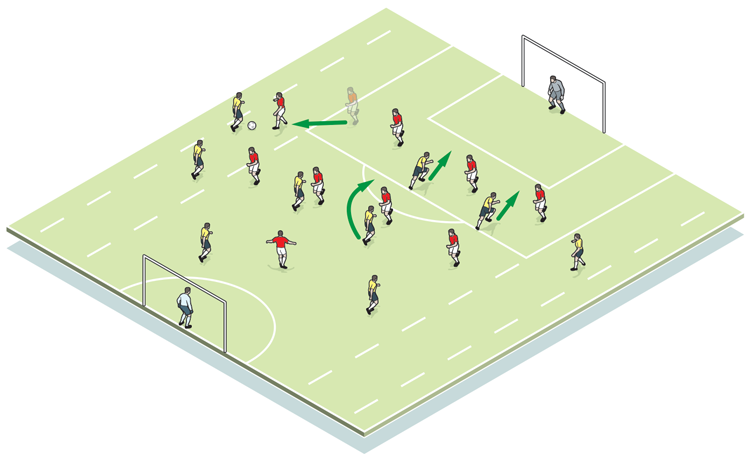Attacking wing play and shooting
This session is about attacking from three different positions and is something that offers versatility in the final third, which is always essential.
| Area | Half pitch |
| Equipment | Cones, balls |
| No. of Players | 7 upwards to 20 (one goalkeeper, varying combinations of outfield players) |
This session is about attacking from three different positions and is something that offers versatility in the final third, which is always essential.
We begin with shooting from outside the box, setting up opportunities for powerful accurate shots into the net.
Moving on, we look at quick, instinctive interplay on the wing, finishing with a cross into the danger area. Plus we examine the roles of attacking first and second waves of crosses.
It’s essential to practise these in order to fine-tune the movement of strikers, quality of delivery,and inventive combinations on the wing.
This is a powerful and insightful session that encourages players to practise hard, perfect their roles and reinforce habits.
Main session
What do I get the players to do?
Use one defender, one attacker, two midfielders and two wide players. This is a two-ball routine.
Positioned outside the D of the penalty box, the midfielder links with the striker and has a shot (1).
With the second ball, the other midfielder switches the play out wide (2). The two wide players combine and put a cross in for the inrushing forward and attacking midfielder (3). The defender tries to clear the ball.
The crosser must be aware of the defender’s position. As a coach you can make the defender defend either the near post or back post cross.
1

2

3

How do I progress the session?
Progress this session to a three-ball routine with a complete back four plus a defensive midfielder to defend. Add wingers on the other side on the pitch and an extra attacker and midfielder.
The midfield players now work in pairs. Together with the striker, they try to outplay an opponent in order to get a shot on goal. The attacker who previously laid the pass off can now spin away from his marker and shoot. Strikers should run in anticipating rebounds (4).
In the next phase, the full-back must try to stop the wide men from crossing. The wide men must try to outplay the full-back in a 3v1 situation (5).
When this ball goes dead, the opposite wide men put another cross in for the attackers and defenders to react to (6).
Defenders and strikers must always readjust their positions to deal with the next ball arriving. The aim is to make the routine more competitive and, at the same time, demand more creativity and unpredictability in forward play.
4

5

6

What are the key things to look out for technically/tactically?
We are looking for accuracy of passing and finishing, plus a variety of crosses. On the wings, rhythm and flow of passing is essential, and players must protect against mistimed runs or erratic passes.
The strikers in the middle must be mobile and versatile – they must run to the near post and far post, whilst still being prepared to receive passes in and around the penalty spot or further back.
Game
How would you put this into a game situation?
Work this into a 10v10 game (including goalkeepers) across a half-pitch, marking out two wing channels.
Only one defender can enter the wide zone to defend the cross. This encourages 2v1 situations on the wing and ensures many crosses into the penalty area (7).
The approach should be varied, sometimes attacking down the wing to fire a cross into the six-yard box, on other occasions cutting back inside to set-up a long-range shooting chance (8).
If a ball from the wing is delivered into the box, players must finish using one touch (9). Award two goals for crosses that finish with a header or a volley. If the defending team wins possession, they break upfield.
This game would usually last 45 minutes. The training session in total takes 75 minutes.
7

8

9

Related Files
More like this
Editor's Picks
Deep runs in the final third
Using the goalkeeper in build-up play
Pressing principles
Intensive boxes drill with goals
Penetrating the final third
Creating and finishing
My philosophy
Pressing initiation
Compact team movement
Coaches' Testimonials

Alan Pardew

Arsène Wenger

Brendan Rodgers

Carlos Carvalhal

José Mourinho

Jürgen Klopp

Pep Guardiola

Roy Hodgson

Sir Alex Ferguson

Steven Gerrard
Coaches' Testimonials

Gerald Kearney, Downtown Las Vegas Soccer Club

Paul Butler, Florida, USA

Rick Shields, Springboro, USA

Tony Green, Pierrefonds Titans, Quebec, Canada
Join the world's leading coaches and managers and discover for yourself one of the best kept secrets in coaching. No other training tool on the planet is written or read by the calibre of names you’ll find in Elite Soccer.
In a recent survey 92% of subscribers said Elite Soccer makes them more confident, 89% said it makes them a more effective coach and 91% said it makes them more inspired.
Get Monthly Inspiration
All the latest techniques and approaches
Since 2010 Elite Soccer has given subscribers exclusive insight into the training ground practices of the world’s best coaches. Published in partnership with the League Managers Association we have unparalleled access to the leading lights in the English leagues, as well as a host of international managers.
Elite Soccer exclusively features sessions written by the coaches themselves. There are no observed sessions and no sessions “in the style of”, just first-hand advice delivered direct to you from the coach.









